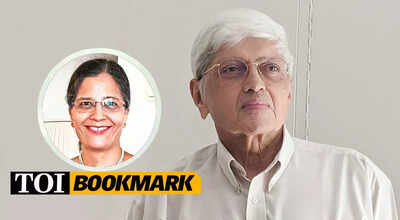Listen here:Excerpts from the conversation:Q: What was the genesis of the book?A: The genesis was the publisher, David Davidar, who had chanced upon a book called ‘A Personal History of Ireland Since 1958’ written by Fintan O’Toole. He sent it to me saying, Gopal, would you like to take a look at it? And if you think you like the book, would you like to attempt a similar book on independent India? So I said, gosh, that’s a tall one. But then I saw around me at home a lot of photographs from old times, archives, letters. And I said, maybe these old papers deserve to be dusted up and put into a narrative. And maybe Fintan O’Toole has just given me the chance to do so. And I told David, I am on board. That’s how it started.Q: What was it that appealed to you in that book that made you feel that there was a possibility in your attempting this as well?A: See, Fintan O’Toole, unlike me, is a very lively person. With a lot of things that have happened in his life which make his life interesting. So that was a big difference. Mine has been a very boring and humdrum life, but Fintan’s has not been. But it was the structure of his book that held out some hope and promise for me. The structure was like this year by year, giving the name of what happened in that year as the title for that year. He has traversed the history of the Republic of Ireland with some of his own personal stuff put into it. And it seemed to me like a spoken calendar, a verbal diary. And I said, I think this interests me. And the structure and the form of Fintan O’Toole’s gripped me as much as the content.Q: When you were writing the ‘Undying Light’, albeit it’s a memoir, you’re looking at the personal documentation. How many layers of writing did it require before you reached this point of being able to publish it?A: That’s an important question, both from the standpoint of writing as such and from the viewpoint of writing this particular book. As a columnist of Monthly Columns, I have had a working principle, you may call it working procedure, perhaps, by which I write to the fullest scope of what I want to say and then trim it down to the word count that has been given to me. That’s how I wrote this. I put in all that I thought was necessary and then trimmed it down chapter by chapter, to the word count that my publisher had prescribed for me. And so layers is a very good expression. It is a layering, layering by my own sense of what needs to be said, and then a paring of that layering to what the publisher thinks is the right shape and size.Q: How long did it take you to write this manuscript?A: It took me two and a half years. But those two and a half years were not devoted solely to the writing of this book. They were full of my life, my life with my grandchildren, with my children, with my family and with my teaching and writing of columns. So in shared time shared with family, friends and commitments, it took two and a half years. If I was doing only this and nothing else, I might have finished it in a year.Q: When recounting for the sake of putting it down in writing and telling a story to a larger audience, many of whom you don’t know, how do you find your voice in that space?A: There were two, three criteria which I had given to myself. One was difficult. I am writing about what I have seen, heard, experienced and because I’ve seen, heard and experienced. But I should not put myself at the centre of what I am writing. I should say what I know egolessly and as far as possible without using the letter, single letter word. It is difficult. But I did try to do so. I tried to mute my voice while I found my words.Q: If anyone needs a good start of understanding how and what our democracy is and how it can work, it is to read this amazing document, this visionary document.A: You know, you’re right. And here, if I may narrate a small incident. When I was working in West Bengal, I went to a village in Murshidabad which is at the moment the scene of a great deal of violence. I went to a village where they make bidis, handmade cigarettes. Smoking is an unhealthy thing and it is very rightly under great control now. But I went to see how the bidi is being made and what the life of the bidi makers is like. There were almost no men in the village. They had all gone out to work or to seek work. Women, mothers and their daughters were rolling these bidis from material that had been given to them by middlemen. And I went to one hut with a young girl, small girl, she was about 12 or so. And I said, are you not in school today? And she was so frank, she said, no, sir, I am not in school because you were coming. Our school has been shut today. And I felt so bad about it. But then I asked her, okay, can I see your books which you read? She went and opened a small box in her hut and brought out a book in a brown paper cover. And I saw it was the Constitution of India in English. I asked her if she had read it. And she said she had. So I said, can you recite any one line? And she stepped back, stood straight, hands down, chin up, and recited for me the Preamble of India or the Constitution of India. ‘We, the people of India’. My heart trembled, my lips went dry, my hands shook in amazement. And I said to her in my mind, one day you will be the President of India.Q: You have been a bureaucrat, and a diplomat, and upon your retirement, governor of West Bengal. You have seen the Constitution work in so many different ways. And that is what I have really enjoyed reading the subtext in your memoir.A: I am glad you are emphasising the importance of the Constitution as such and the place of the Constitution in this book. I can’t help but say here, that the Preamble, which is a lyrical document, has been translated with the rest of the Constitution in all the languages of India. But the Sanskrit translation of Preamble starts with ‘We the people of India’ as ‘Vayam Bharatasya jana’ and the Urdu translation starts with ‘Hum hind ki avam’. There is an extraordinary lyrical voltage to ‘Vayam Bharatasya jana’ and ‘Hum Hind ki avam’ which takes it even beyond the English. We the people of India. This book is about the people of India both as a collectivity and as so many individuals.
A Spoken Calendar: Independent India Through the Eyes of its People | India News












